During migration and winter we have a lot of birds in the grass–birds that fly up and dive down a little distance away, birds that fly up and perch in bushes, birds that fly up and away and dive down over there. Most of them are sparrows of some kind. Today one of the “divers” posed long enough for me to note salient characteristics and even get some slightly blurry pictures–good enough for an ID:
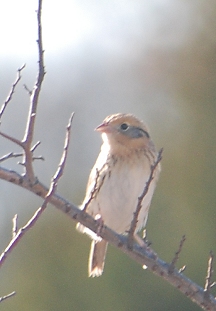
This is a LeConte’s Sparrow, Ammodramus leconteii. which migrates through here and also sometimes spends the winter. This is the first one I’ve been sure of. I will spare you all the difficulties I had photographing it. (Or putting the correct ID on the file–for some reason I had another sparrow name on the brain and wrote down the wrong one while looking at the right one.) It’s a beautiful little bird; these images hardly do it justice. Right after I took the last image, it dove off that twig into the knee-high grass below.
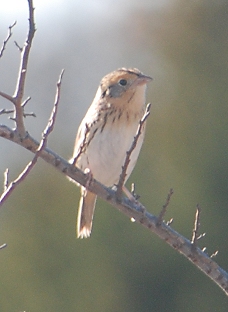
After a new species, what could I do but look at the grass in hopes of spotting something else interesting?
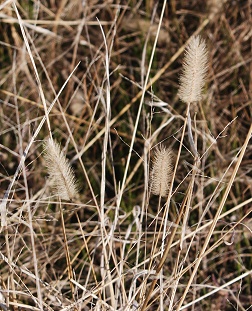
This is knotroot bristlegrass (a name that’s fun to say fast), a favorite food of painted buntings. It likes to grow in damper areas; here, it’s in the near meadow “drainage channel.” At this time of year, the seeds have fallen, leaving the bristles glowing in the slanting light.
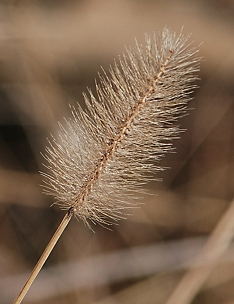
Nearby, thanks to a half inch of rain over the past couple of days, the pool below the Number 3 gabion is flowing again:
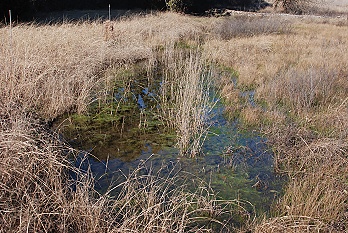
I walked up past the gabion and started up the old ditch line, checking water clarity and such, and planning to look for crawdads in the largest pool in the old ditch, when–suddenly and very impressively–a great blue heron stood up in that pool, spread its vast wings and took off, flying toward the highway. I was so startled that I didn’t get a picture right away and my first ones were completely out of focus, but then, as it turned to parallel the highway and than come back west along the line of the natural drainage, north of the old ditch, I got some half-way decent shots:
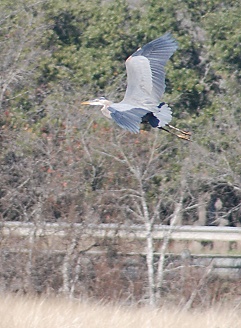
You can see the guard rail of the highway behind the trees–the heron has turned parallel to the highway and is going to double back to the natural drainage, which also has various pools on it. I didn’t realize the big heron hunted these little pools, mostly only a few inches deep.
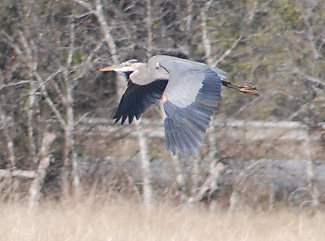
The heron is already starting to come down and slide towards a chosen landing site.
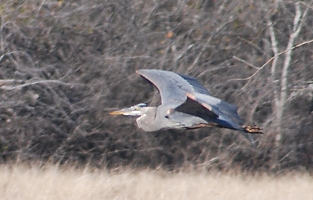
And here the heron is flying just above the natural drainage channel–the trees are on the north fenceline.
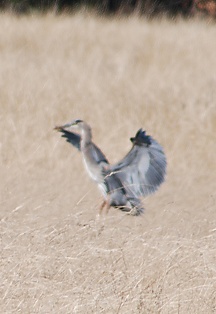
Landing…we can’t see the water but I know it’s there and I’m sure that’s where the bird is. Here’s a link to an earlier post that shows both the ditch pool the heron left from, and the east grass pool it landed in.
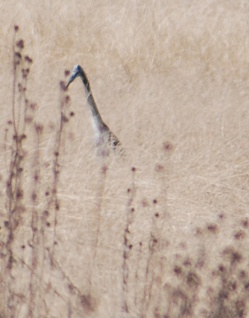
The watcher is being watched…although this shot shows the bird slightly more relaxed than the previous, with the beak pointed right at me. After standing still to take all the pictures, I turned away and opened distance between us–didn’t want to bother the heron any longer. I went up to the dry woods instead, to check the rain gauge at Fox Pavilion and try (unsuccessfully) to photograph a backlit Dainty Sulphur butterfly.
Comment by Adrianne Middleton — December 30, 2009 @ 8:09 pm
Those are amazing photos of the heron. I love the way its wings flex in flight. And it’s interesting that it holds its head tight against its body rather than stretching it out. I would guess stretched out would be more aerodynamic.
I’ll never look at fluffy grass the same way again. Now I’ll be looking at the color and the structure.
Comment by Steve Willson — December 30, 2009 @ 8:38 pm
I enjoy reading about the work you are doing on your property. It’s always exciting to find new species. I’ve been searching Blue Jay Barrens for 26 years and still add a couple of new plants each year.
Great Blue Herons will hunt just about anywhere they can find food. We had one eat the goldfish out of a 100 gallon stock tub located outside our front door.
Comment by Doranna — December 30, 2009 @ 9:26 pm
What a pretty little sparrow! Happy new species!
Comment by elizabeth — December 30, 2009 @ 9:49 pm
When I saw it through the binocs, I knew immediately it was new to me (and the place)–it’s so delicately marked–and yet I also love the bold markings of Harris’s or Song Sparrows.
Comment by elizabeth — December 30, 2009 @ 9:51 pm
I’m still wondering what they’re finding in those ephemeral grassland pools. It was so dry for so long–too late for frogs to make up there, I’m thinking. (Not that I usually see frogs there any time.) Do you suppose herons would go after small mammals, like mice or voles?
Comment by Adrianne Middleton — December 30, 2009 @ 10:14 pm
How about crawdads and roots and tubers? The birds I’ve met tend to be remarkably omnivorous. And crawdads are amazingly able to survive droughts.
A
Comment by elizabeth — December 30, 2009 @ 11:12 pm
Herons typically fly “folded”–like pelicans–and the folded shape is aerodynamic. It was interesting watching this heron in its short flight, because at takeoff its head and neck were extended (I have a blurry picture of that) and then it retracted its neck.
Comment by elizabeth — December 30, 2009 @ 11:15 pm
We do have crawdads–I was amazed at how fast they came back (as evidenced by their chimneys and burrows) when the rains started in September. And something (I thought ‘coons, but maybe herons?) has been digging out some of the burrows near the #3 gabion pond.
Roots & tubers…not much to go on there, unless they’re crazy about wild onions.
Comment by Steve Willson — December 31, 2009 @ 8:15 am
Herons are strictly carnivorous and besides fish and other aquatic life, will eat just about any small mammal, bird, crustacean, reptile or amphibian they can find. I often see them hunting in temporarily flooded pasture and crop fields where the prey would have to be something terrestrial.
Comment by cdozo — December 31, 2009 @ 10:35 am
These pictures are so beautiful. It sounds like it was a wonderful walk. Two cool birds and some wonderful grass. Who could ask for more.
Happy New Year!
Comment by elizabeth — December 31, 2009 @ 11:07 am
Steve–thanks for info on these herons hunting in wet pastures as well as more permanent water, and on their eating mammals and reptiles as well as fish, crawfish, and amphibians. Since I had a snake-eating chicken once (no kidding–rooster killed a rough green snake) and
Carol–it was indeed a wonderful walk. There were more cool birds that I didn’t get a picture of. Hoping to get out again today (should be in the 60s) to see even more and get more pictures (I hope.) Cold front again tonight.
Comment by Claire Eamer — January 2, 2010 @ 2:33 pm
We’ve spent the last two weeks in a highrise in Vancouver. There’s a heron that spends most of the day, and a good bit of the night, perched on a small block on top of a nearby highrise. It appears to consider the Vancouver West End its territory. High aspirations, even for a big bird!
Comment by Matthew Sarver — March 3, 2010 @ 10:17 am
LeConte’s Sparrows are one my favorite species! So tough to get a look at in winter, though. In the South Carolina Lowcountry, they will occasionally sing in winter right around sunrise. I had two birds singing last year down there, but never saw either.
Comment by elizabeth — March 3, 2010 @ 1:38 pm
Winter’s the only time we have them…and this is the first time I’ve seen one except as a fast little bird disappearing into the grass again quickly. They are beautiful!